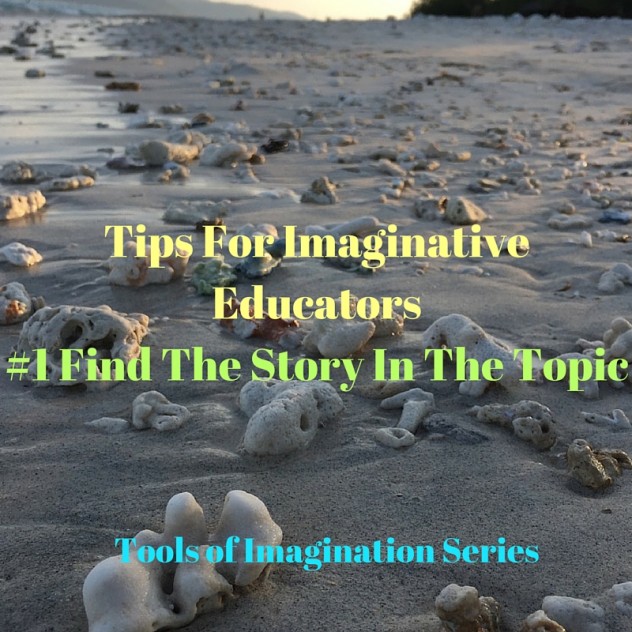Tools of Imagination Series
#1 Find The Story In The Topic
Here’s the golden rule of imaginative teaching: Identify the emotional significance of the topics you are teaching.
That is, identify what it is about the topic that evokes your sense of wonder. On one level, this is obvious. Students know when their teachers are interested or engaged in a topic. A teacher’s passion and enthusiasm in general can inspire students to learn. In imaginative teaching, the teacher’s engagement with the curriculum lies at the very heart of effective and imaginative teaching. It is not an option. It is not a frill. A teacher’s emotional engagement with a curriculum topic is an essential part of all good teaching. Finding an emotional connection to a topic is how you find the story; it is the first and most important step towards teaching as storytelling.
The Good News
Any and all topics in the curriculum can be story-shaped. Whether primary explorations of colour, advanced study of quantum physics, a lesson on counting to 100, or exploration of world literature, topics that are taught in ways that leave students feeling a human emotion such as care, concern, awe, fear, intrigue etc. are more meaningful and memorable. This is the great educational power of the story.
More Good News
All human beings make meaning in their lives in storied ways: all human beings feel something for the events in their lives. If I asked you how 2016 has been treating you so far, you would tell me a “story”; you would describe your year in a way that would leave me feeling something about the events that have shaped it so far. This is “story-shaping”; it connects human emotion to information. The trick for effective teaching is to tie up emotional responses with the curriculum content you are dealing with.
Remember the golden rule:
Begin with your emotional engagement–find your story–and you will be able to evoke the wonder in your math concepts, language arts concepts, or biology lessons.
Story? Storytelling?
Let me clarify terms. Using “story” does not mean you necessarily have to create a fictional story. Nor does it mean that you must tell your students personal stories. Lastly, it does not mean finding a “story” you can read along with all of your lessons. These activities are uses of story and may, on one level, support learning and formation of relationships with your students, but they do not tap into the potency of the story tool for imaginative learning.
For the imaginative educator, a “story” is more profound: it is a way of shaping information to bring out its emotional importance.
I have had the great honour of learning about the power of story from a master thinker and teacher: Kieran Egan. Over the course of his rich career he has focused a lot of his energy on describing the power of story for teaching and learning. The Center for Imagination in Research Culture and Education (CIRCE/formerly the IERG) has spent over a decade bringing his ideas into practical reality.
For Example: Punctuation
If you want your students to learn to effectively use punctuation, you’ll be more effective if they feel something about it. So, remembering our golden rule, start by asking yourself: What’s the story on punctuation? How is punctuation wonder-ful? (These may not be questions that you have ever asked yourself before. I know.)
I’m curious…what do you think about punctuation? (I would love to know what you think…Post a comment below!)
One thought I had is that punctuation marks are ingenious; they are tidy little packages of meaning that help convey body language that we physically experience in face-to-face interactions but that is lost in written communication. Imagine, for example, the facial expressions and bodily gestures that may be conveyed with an “!” Or, think about the way a “;” can replace a wink (e.g. I got a new car; it is a midnight blue Mazarati.) This could be my story on punctuation: punctuation marks are unsung heroes; they are great conveyors of meaning upon which human beings rely for clarity in all aspects of life.
Summary Of Tip #1
Find the story in the topic you are teaching. To do that begin all teaching/planning by feeling your way into a topic. Explore with your emotions alert. Seek what it is about the topic that engages your passion or evokes your sense of wonder. When you have found that emotional core then you, like the reporter sent to get “the story” on some news-worthy event, know what emotional aspect you can evoke to engage your students in the topic.
Stay tuned for the rest of the Tools of Imagination Series. Learn what features of story-shaped lessons will most engage your students.



Goodness! What a wonderful way of approaching the content that you teach! I don’t think I ever realized that I, myself, approach what I am learning from an emotional viewpoint, but I most certainly do! I can’t wait to read the rest of these tips!
I go gaga for great punctuation: well-placed colons draw attention to a great point; semi-colons connect related ideas; commas allow you to pause, or to insert information, while also adding a breathing moment; and, exclamation points allow you to express your excitement about all of these things! Fabulous, don’t you think?
We are kindred spirits Christopher! They are magical little marks.
Ah yes! The story of punctuation. Years ago (literally…I mean, like 23 years ago) I was a teaching assistant at Temple University. I was teaching an Introduction to Composition course, one of the basic courses required for all students. The particular class in which I introduced this assignment, which I have since done with numerous middle and high school classes, was a Saturday class, filled with continuing education students, most of whom were 10 or 15 years my senior.
Anyway, when it comes to punctuation, I’d discovered that if one could learn the comma (assuming that you’d figured out the period and question mark by then) then you could basically learn all of the main parts of sentences (clauses, phrases, etc). So we’d been doing some work in their mandated grammar text on commas and it just wasn’t sinking in. The darn crooked period’s a wiggly little bugger to figure out.
So, in order to work out their discomfort with the comma, I asked them to do a freewriting about it. The prompt was something like this: “If I were a comma I would be…” I recall that mine used the image of the conductor of an orchestra, as I saw the comma as a conductor of rhythm, pacing, and phrasing.
But the one that blew me away was “…I would be the Mel Gibson of Commas.” This author went on to describe how he would or would not be a comma as described by each of Mel Gibson’s staring roles at that time. So there was a Mad Max comma, Mad Max Beyond Thunderdome, Comma-let (Hamlet), and several others. It was brilliant. And did he feel something about that comma? You’re darn right he did.
This is a fantastic memory Garreth. What a great teaching moment.Thanks for sharing. Mel Gibson comma …honestly!? Would welcome other accounts of your imaginative teaching for imaginED!
I’m working on a longer blog post. Just have to finish my summer job and get ready for school…but I’ll write it.
Sounds good. Be in touch!
Punctuation saves lives:
Let’s eat children!
Let’s eat, children!